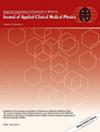Monte Carlo analysis of energy deposition and X-ray fluence in cylindrical anode systems
Abstract
Background
Cylindrical anode X-ray systems are increasingly used in multisource imaging; however, electron beam interactions with the curved anodes cause geometric distortions that alter energy deposition and X-ray emission. Understanding these effects is key to optimizing system performance.
Purpose
This study uses Monte Carlo (MC) simulations to examine how electron beam size, anode radius, and polar angle influence energy deposition and X-ray fluence in cylindrical anode setups, and to quantify the distortions and energy redistribution for improved X-ray generation efficiency and beam stability.
Methods
MC simulations were performed with electron beams (0.5 × 0.5 mm and 2 × 2 mm, 120 keV) on cylindrical tungsten anodes with radii from 1 to 5 cm and polar angles from 20.5° to 71.8°. Energy deposition profiles, dimensions, and photon fluence distributions were analyzed using the FLUKA MC package, with mapping in cylindrical coordinates (r-ϕ-z).
Results
Energy deposition profiles varied with beam position and anode curvature. The axial full width at half maximum (FWHM) increased by up to 650% at larger polar angles, while the azimuthal FWHM decreased up to 50%. Larger anode radii reduced the azimuthal FWHM by up to 78%, with minimal changes in axial and radial components. Narrower beams (0.5 × 0.5 mm2) produced smaller, more symmetric energy deposition profiles on anode surface. Overshoot occurred at small radii and large polar angles, leading to incomplete energy deposition.
Conclusions
Larger anode radii and moderate polar angles minimized energy deposition profiles distortion and improved X-ray fluence uniformity and production efficiency. Overshooting at small radii and large angles caused deformation, emphasizing the need for precise beam positioning to balance distortion, uniformity, and efficiency. These results define the geometric limits for effective energy deposition profile formation in cylindrical anode systems.


 求助内容:
求助内容: 应助结果提醒方式:
应助结果提醒方式:


